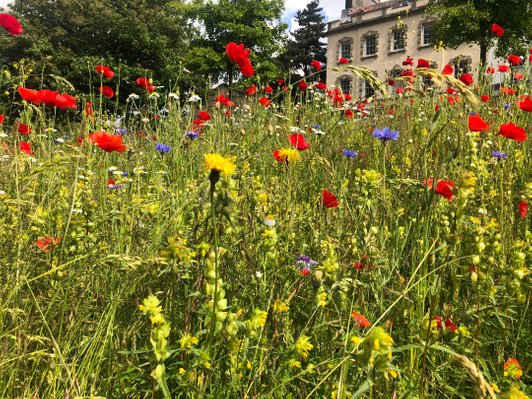Clifton Hill Meadow
This sunny slope on Clifton Hill has been managed as grass lawn by the council for many years, but it was part of the original Clifton village green. A recent survey by the Avon Wildlife Trust showed that it was also formerly a meadow: the trust found seeds from 33 different wildflower species in the soil.
In the summer of 2021, local ecological group West Bristol Climate Action ran a public consultation to see whether residents and visitors would like the grassy bank to be turned into a meadow, and 99% of over 300 people who replied were in favour. A crowdfunder to raise money for seeds and plug-plants hit its target within 48 hours.
Since then, the council has changed its mowing regime and volunteers organised by West Bristol Climate Action have started to sow and plant 59 species of wildflowers to add to the ones already waiting in the soil.
There are three banks on Clifton Hill, separated by paths, and various techniques of growing wildflowers are being tried on them. All the methods will be good for pollinators such as bees and butterflies.
The westmost bank – the meadow – is being cut once or twice a year (April and September) and the grass cuttings are removed so that they don’t refertilise the soil. Over time, the soil becomes less fertile, and this favours wildflowers instead of coarse grass.
The two easterly banks are being turned into wildflower ‘floral lawn’, which is cut more regularly so that the flowers remain low. This means that the area can still be used for picnics, while still supporting insects. Again, grass cuttings will be removed to strip nutrients out of the soil to favour the wildflowers.
The meadow area itself has been split into three sections, each treated differently to see which grows best. The eastmost section has hand-turned soil, and the middle had shallow cuts made in it. Both were seeded in November 2021. The westmost section was broken up by a rotating blade, for seeding in April 2022.
And there is also a section that has been left unseeded and unplanted to allow the original meadow flowers to come through as the fertility of the soil drops.
Over time, as management continues, different species of flowers will come and go. Each prefers different times of year to bloom and takes different amounts of time to establish.
West Bristol Climate Action hope that if you own a garden, or want to help a local area follow a similar path, you’ll copy what you see at Clifton Hill and help turn Bristol into a giant nature-reserve mosaic.
More information – including how to make a meadow or floral lawn in your garden, and
how to volunteer to help – can be found on the West Bristol Climate Action website.
